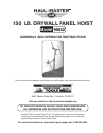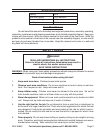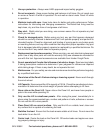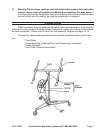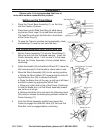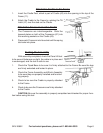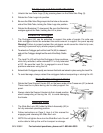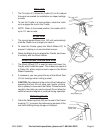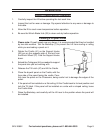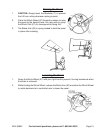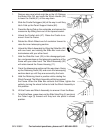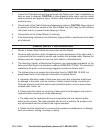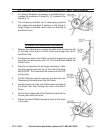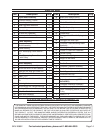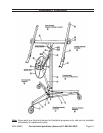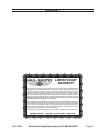
Page 12SKU 95852
For technical questions, please call 1-800-444-3353
MAINTENANCE
Inspect the Cable before beginning work each day. Replace the Cable immediately as
soon as wear is detected. CAUTION: A cable breaking while under load can cause
severe personal and property injury. Broken cable strands are sharp and can cause
puncture injury.
Occasionally oil the Cable Pulleys and telescoping sections. CAUTION: Never allow oil
or grease to contact the surface of the Winch Brake Hub (33). Keep the Winch Brake
Hub clean and dry to prevent brake slipping or failure.
Occasionally oil the Caster Wheel (4) bearings.
If the telescoping sections do not slide freely, apply paraffin or candle wax to the sides
as a lubricant.
CABLE SAFETY INFORMATION
Woven or twisted Steel Cables are also known as Wire Ropes.
Since the safe operation of this lift depends on safe maintenance of the steel cable, it
is important that you carefully monitor and maintain the included cable. Replace the
cable as soon as it appears to have any fault, defect or noticeable wear.
The American Society of Mechanical Engineers has promulgated standards for the
safe use of Wire Rope in its standard numbered ASME B30 19-2000. This standard is
available to the public, and we strongly suggest you become familiar with it.
The following does not replace the information found in ASME B30 19-2000, but
paraphrases some of the important information contained therein.
a. Inspection should be made at least once every work day. Inspection should look
for damage to the cable, such as crushing, kinking, broken strands, corrosion etc.
Particular attention should be paid to wear and stress points, such as near pulleys,
crimped ends, hooks, etc.
b. Cables should be taken out of service if discovered to be damaged, and must be
replaced before resuming use of the affected tool.
c. The cable must be replaced with one of comparable size and material quality,
suited to the purpose. The cable provided with this Lift is suited to the purpose, and
any replacement must be at least to the original standard.
d. Cables must be maintained in a manner that prevents unneeded wear or damage,
such as corrosion, kinking, crushing or cutting.
1.
2.
3.
4.
1.
2.
3.
4.



